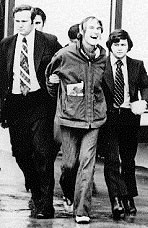http://en.wikipedia.org/wiki/History_of_LSD
Dr. Leary began conducting experiments with psilocybin in 1960 on himself and a number of Harvard graduate students after trying hallucinogenic mushrooms used in Native American religious rituals while visiting Mexico. His group began conducting experiments on state prisoners, where they claimed a 90% success rate preventing repeat offenses. Later reexamination of Leary’s data reveals his results to be skewed, whether intentionally or not; the percent of men in the study who ended up back in prison later in life was approximately 2% lower than the usual rate.
Well, the question is this: Was the drop from 92% down to 90% explained by random chance, or did the LSD really have a statistically significant impact on reducing the crime rate? Since the text does not provide a sample size, I will just use n=100 to do the math.
The calculations:
H0: LSD takers had no difference in their repeat offense rates.
HA: LSD takers did have a difference in their repeat offense rates.
First, take stock of the given information:
\(n = 100 \\\\ p = .92 \\\\ \hat{p}=.90\)
Next, you calculate the standard deviation of samples of this size.
\(SD(\hat{p})= \sqrt{\frac{(.92)(.08)}{100}}=.03\)
To determine how unlikely your sampling result was, you calculate how many standard deviations away from the expected proportion it was (Z-score).
\(Z(\hat{p})= \frac{\hat{p}-p_0}{SD(\hat{p})}=\frac{.90-.92}{.03}=-.67\)
Then, you calculate the odds of getting this Z-score via the normal cumulative distribution function. (What are the odds of this happening randomly?) If it’s under 5%, then you reject the null hypothesis, because it’s unlikely this variation can be attributed to random chance. ie: Odds are, the hair is indeed different.
\(p(Z \le -.67) = .25 = 25\% \)
Conclusion: If the odds of being a repeat offender is 92%, then the odds of having 90% (or less) repeat offenders in a random sample of 100 men is quite likely. The math shows that the odds of this reduction simply happening by chance (random variations) is 25%. This is large enough (over 5%), that we can not assume the LSD had any true effect on reducing crime rate. ie: The 2% reduction was probably due to chance. So, we accept the null hypothesis (H0): In a sample of 100 test subjects, the LSD had no effect if it only reduced the repeat offender rate to 90%.

So, do you have the same lingering question that I did? How large would the sample size have to be in order for the 2% drop to not be an accident? (Recall, I just made up n=100). Well, some simple algebra should answer this for us:
First, let’s determine the Z-score at the 5th percentile:
\(invNorm(.05) = -1.64 \)
Let’s use that in the Z-score calculation to figure out what standard deviation we’d need
\(-1.64 = \frac{.90-.92}{SD}\) (…SD = .012)
Backing this into the SD formula will help us solve for the sample size (n)
\(.012= \sqrt{\frac{(.92)(.08)}{n}}\) (…n = 495)
So, if Timothy Leary showed a repeat offender drop of 2% with a sample size of 495, then we could say the LSD did have an effect. Why? Because that much of a drop only has a 5% chance of happening randomly.
